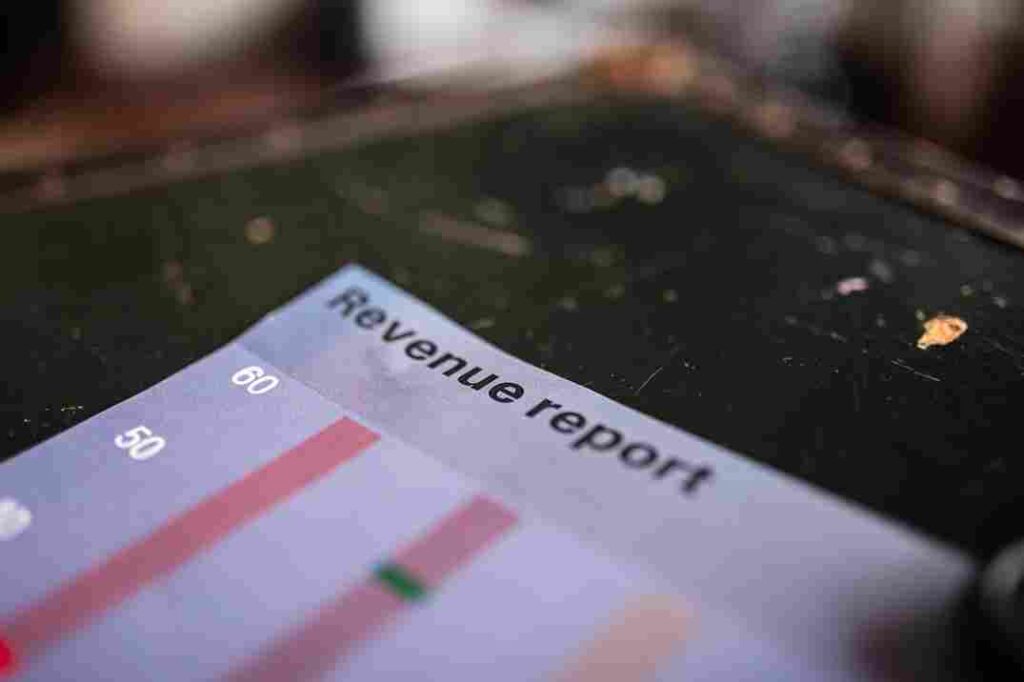Profit and revenue are two important financial terms that often get used interchangeably, but they have distinct meanings in the business world. Understanding the difference between profit and revenue is crucial for anyone involved in managing or analyzing a company’s finances.
Revenue refers to the total amount of money earned by a business from its regular activities. It includes all sales of goods or services made during a specific period, without taking into account any deductions or expenses. On the other hand, profit represents the financial gain realized after subtracting all expenses from the total revenue. In simpler terms, profit is what remains when you deduct costs such as production, salaries, taxes, and other operating expenses from your revenue.
In a nutshell, while revenue reflects an organization’s top-line income generated through its core operations, profit measures how effectively it manages those operations by considering all associated costs. By understanding this fundamental distinction between profit and revenue, businesses can make informed decisions about their financial health and take necessary steps to maximize profitability.
Profit and Revenue Key Distinction points
When it comes to business finances, understanding the difference between profit and revenue is essential. While they are related, these terms refer to different aspects of a company’s financial performance. Let’s break down what each term means:
- Revenue: Revenue represents the total amount of money generated from sales or services provided by a business within a specific period. It is often referred to as top-line or gross income.
- Profit: Profit refers to the amount left after subtracting all expenses incurred in running the business from the total revenue earned during a particular period. It is also known as net income or bottom line.
To further understand their differences, let’s compare revenue and profit side by side:
| Revenue | Profit | |
|---|---|---|
| Definition | Total earnings from sales/services | Income remaining after deducting expenses |
| Calculation | Sales/Service Price x Quantity | Revenue – Expenses |
| Focus | Top-line growth | Bottom-line growth |
| Importance | Indicates market demand for products/services | Reflects overall financial health |
While both metrics are crucial for evaluating a company’s financial performance, profit provides deeper insights into its profitability and sustainability over time.
It’s important to note that generating high revenue does not guarantee profitability if expenses exceed income. A company can have substantial revenues but still operate at a loss due to excessive costs.
Understanding how revenue and profit interact helps businesses make informed decisions about pricing strategies, cost management, and investment opportunities.
While revenue represents the total amount of money generated through sales or services provided by a business, profit indicates the actual income remaining after deducting all expenses incurred in operating that business. By focusing on both metrics simultaneously, companies can better assess their financial standing and take steps toward sustainable growth.
Defining Profit: A Closer Look
To understand the difference between profit and revenue, it’s crucial to first define what profit actually means. Here, we take a closer look at this important financial concept:
Profit Definition:
Profit is the financial gain obtained after deducting all expenses from total revenue.
Key Components of Profit:
- Revenue: The total amount of money generated from sales or services provided.
- Expenses: The costs incurred in operating a business, including salaries, rent, utilities, raw materials, etc.
Gross Profit vs Net Profit:
- Gross Profit: This represents the revenue remaining after subtracting the cost of goods sold (COGS). It indicates how efficiently a company utilizes its resources to produce and sell products.
- Net Profit: Also known as the “bottom line,” net profit shows the overall profitability of a company after accounting for all expenses (including COGS) such as taxes, interest payments, and depreciation/amortization.
Importance of Understanding Profit:
- Financial Assessment: Assessing profit helps businesses gauge their performance and make informed decisions about future investments and strategies.
- Investor Confidence: Investors analyze profits to evaluate a company’s stability and potential returns on investment.
Factors Influencing Profits:
- Pricing Strategy: Setting appropriate prices can impact both revenue generation and profit margins.
- Cost Management: Controlling expenses through efficient operations can increase overall profitability.
Profit Margin Calculation:
\[Profit Margin = \frac{Net\;Profit}{Revenue} × 100\%\]
Understanding these fundamental aspects of profit is essential for businesses aiming to optimize their financial outcomes while maintaining sustainable growth.
Note that while this section explains what profit entails at a high level, subsequent sections will delve deeper into specific aspects related to both profit and revenue.
Exploring Revenue: The Basics
Revenue is a crucial concept in business and understanding it is essential for any entrepreneur or business owner. In this section, we will delve into the basics of revenue, including what it is and how it differs from profit.
Here are key points to consider when exploring revenue:
- Definition of Revenue: Revenue refers to the total amount of money generated by a company through its primary operations over a specific period. It represents the income received from selling goods or services.
- Differentiating Revenue from Profit: While revenue represents the total amount earned, profit refers to the financial gain that remains after deducting expenses from revenue. Profit takes into account various costs such as production, marketing, overheads, and taxes.
- Importance of Tracking Revenue: Monitoring your company’s revenue is vital for evaluating its financial health and performance. By analyzing trends in revenue growth, you can identify areas where improvements can be made and make informed decisions about resource allocation.
- Sources of Revenue: Businesses generate revenue through different channels depending on their nature and industry sector. Some common sources include product sales, service fees, subscriptions, advertising revenues (for media platforms), licensing fees (for intellectual property), etc.
- Calculating Total Revenue: To calculate total revenue accurately, multiply the quantity of units sold by their respective prices per unit within a given time frame—for example:
Total Revenue = Quantity Sold × Price Per Unit - Understanding Net vs Gross Revenue: Gross revenue represents the total income before any deductions while net revenue accounts for factors like returns/refunds or discounts provided to customers.
- Considerations for Accurate Reporting: When reporting on your company’s revenues ensure consistency across all reports which includes using standardized accounting methods like accrual basis accounting versus cash basis accounting.
Remember that accurate tracking and analysis of your business’s revenues are critical for making informed decisions and driving growth. In the next section, we will explore profit in detail to further differentiate it from revenue.
Keep reading to gain a comprehensive understanding of the differences between profit and revenue.
Key Differences Between Profit and Revenue
Definition:
- Revenue refers to the total amount of money generated from sales or services provided by a company.
- Profit, on the other hand, is the financial gain obtained after subtracting all expenses, including costs of production and operating expenses, from revenue.
Focus:
- Revenue primarily focuses on top-line growth and indicates a company’s ability to generate income.
- Profit allows companies to assess their bottom line performance by evaluating their net earnings after deducting costs.
Measurement:
- Revenue can be easily measured as it represents the inflow of cash resulting from sales or services rendered within a specific period.
- Profit is calculated by subtracting various expenses (such as cost of goods sold, overheads) from revenue; hence it requires detailed accounting records and calculations.
Indication of Success:
- Higher revenue generally implies higher business activity but does not necessarily guarantee profitability.
- Profitability indicates whether a business is successful in generating sustainable profits over time.
Long-Term Viability:
- Factors Affecting Growth:
- Increasing revenue can be influenced by factors such as marketing strategies, pricing decisions, customer demand fluctuations,, etc.
- Profit growth is more impacted by cost management practices like operational efficiency improvements or reducing fixed/variable costs.
- Investor Perspective:
– Investors often consider both metrics when evaluating businesses for potential investments.
– High-profit margins indicate better returns while steady revenue growth suggests stability and market presence.
Remember that understanding the distinction between profit and revenue is crucial for businesses as it helps in making informed decisions, setting financial goals, and assessing overall performance.
Factors Influencing Profit and Revenue
There are several key factors that can influence both profit and revenue in a business. Understanding these factors is crucial for effective financial management. Here are some of the main considerations:
- Pricing strategy: The price at which products or services are sold directly impacts both revenue and profit. A well-thought-out pricing strategy ensures that prices align with market demand, competition, and production costs.
- Sales volume: The number of units sold significantly affects both revenue and profit margins. Increasing sales volume can generate higher revenue, but it’s important to consider whether any associated discounts or increased production costs will impact profitability.
- Market demand: Understanding customer needs and preferences helps businesses tailor their offerings to maximize revenue potential. Identifying trends, conducting market research, and staying ahead of competitors’ strategies contribute to capturing a larger share of the market.
- Cost structure: Managing costs effectively plays a crucial role in determining profitability levels. Analyzing fixed costs (e.g., rent) versus variable costs (e.g., raw materials) allows businesses to make informed decisions about cost-cutting measures without compromising quality or customer satisfaction.
- Operational efficiency: Streamlining operations enhances productivity while minimizing waste and inefficiencies, ultimately contributing to improved profits. Implementing lean manufacturing principles or optimizing supply chain processes can help reduce costs while increasing output.
- Competition: Competitive forces within an industry affect both pricing strategies and overall market share dynamics, thereby impacting revenues as well as profits generated by individual businesses operating within the sector.
- Economic factors: Macroeconomic conditions such as inflation rates, interest rates, consumer spending patterns, or economic downturns significantly influence business performance by affecting consumer purchasing power and overall demand for goods/services.
- Marketing efforts: Effective marketing campaigns increase brand awareness leading to greater customer acquisition opportunities which positively impact revenues; however excessive spending on advertising and promotional activities should be carefully monitored to ensure profitability is not compromised.
It’s important for businesses to regularly assess these factors in order to make informed decisions that optimize profit and revenue generation. By understanding the interplay of these elements, businesses can adapt their strategies accordingly and improve their financial performance.
Analyzing the Relationship between Profit and Revenue
When it comes to understanding business finances, it’s crucial to differentiate between profit and revenue. While these terms are related, they represent distinct aspects of a company’s financial performance. In this section, we will analyze the relationship between profit and revenue to gain a deeper understanding of their significance.
Revenue:
- Revenue refers to the total amount of money earned by a business from its primary activities, such as sales of products or services.
- It is commonly known as “top-line” or “gross” income.
- Revenue is typically reported on an organization’s income statement and represents inflows before any deductions.
Profit:
- Profit, on the other hand, represents what remains after deducting all expenses from revenue.
- Also known as “bottom-line” or “net” income, it reflects the financial gain generated by a company.
- Profit can be calculated at various levels: gross profit (revenue minus cost of goods sold), operating profit (gross profit minus operating expenses), and net profit (operating profit minus taxes and interest).
Understanding the Relationship:
The relationship between profit and revenue can provide valuable insights into a company’s financial health:
- Profitability Ratio: Calculating profitability ratios helps assess how effectively a firm converts its revenue into profits. Common ratios include gross margin ratio (gross profit divided by revenue) and net margin ratio (net income divided by revenue). These ratios indicate whether an organization can maintain healthy margins over time.
- Growth Potential: Monitoring changes in both revenue and profits allows businesses to identify trends that may impact future growth opportunities. Consistent growth in both areas suggests positive market demand for products or services offered.
- Cost Management: Analyzing how costs affect profitability helps companies make informed decisions regarding pricing strategies, operational efficiency improvements, or expense reduction initiatives.
Factors Influencing Profit and Revenue:
Several factors can influence the relationship between profit and revenue:
- Pricing Strategy: Setting appropriate prices for products or services affects both revenue and profitability. Striking a balance between maximizing sales volume and maintaining healthy margins is crucial.
- Market Conditions: Changes in market demand, competition, or economic conditions can impact revenue levels. Adapting to these changes while managing costs effectively is key to sustaining profitability.
Understanding the relationship between profit and revenue is essential for evaluating a business’s financial performance. While revenue represents the total income generated from sales activities, profit indicates the amount remaining after deducting expenses. Analyzing this relationship provides valuable insights into a company’s growth potential, cost management strategies, and overall profitability.
Strategies for Maximizing Both Profit and Revenue
To maximize both profit and revenue, businesses need to implement effective strategies that focus on increasing sales and managing costs. Here are some key strategies to consider:
- Focus on customer acquisition: Invest in marketing efforts that target potential customers who are likely to convert into paying clients. This can involve utilizing social media advertising, search engine optimization (SEO), content marketing, and targeted promotional campaigns.
- Optimize pricing strategy: Conduct market research to determine the optimal price point for your products or services. Consider factors such as production costs, competition, customer willingness to pay, and perceived value. Adjusting prices strategically can help boost revenue without sacrificing profitability.
- Upsell and cross-sell: Encourage customers to spend more by offering additional products or services related to their initial purchase (upselling) or complementary offerings (cross-selling). This can be achieved through personalized recommendations during the buying process or post-purchase follow-ups.
- Improve operational efficiency: Streamline internal processes and reduce wasteful practices to minimize costs while maintaining product quality and customer satisfaction levels. Automating repetitive tasks, optimizing supply chain management, negotiating better deals with suppliers, and reducing overhead expenses are all ways to enhance overall efficiency.
- Enhance customer retention: It is typically more cost-effective to retain existing customers than acquire new ones. Implement tactics like loyalty programs, excellent post-sales support, proactive communication channels (such as newsletters), and personalized offers based on past purchases or preferences—all aimed at fostering long-term relationships with customers.
- Expand market reach: Identify untapped markets where your products or services could find demand beyond your current target audience’s scope of coverage—whether it involves exploring new geographical locations or targeting different demographic segments seeking similar solutions.
- Invest in employee development: Skilled employees contribute significantly towards driving business growth while positively impacting customer experience—a critical factor in revenue generation. Invest in training programs, skill enhancement workshops, and performance incentives to motivate employees and boost their productivity.
By implementing these strategies, businesses can optimize both profit and revenue simultaneously. Remember that the specific approach may vary depending on your industry, target market, and business model. Regular monitoring of key performance indicators (KPIs) will help gauge the effectiveness of implemented strategies and allow for adjustments when necessary.
Conclusion
In conclusion, understanding the difference between profit and revenue is crucial for any business owner or aspiring entrepreneur. While both terms are related to financial gains, they represent distinct aspects of a company’s financial performance.
Revenue refers to the total amount of money generated through sales or other income sources. It represents the top line of a company’s income statement and reflects its ability to generate sales. On the other hand, profit is what remains after deducting all expenses from revenue. It indicates how much money a business actually earns, taking into account costs such as production, operating expenses, and taxes.
By grasping this fundamental distinction, entrepreneurs can make informed decisions about pricing strategies, cost management techniques, and overall profitability analysis. Focusing on increasing revenue alone may not necessarily result in higher profits if expenses are not carefully controlled. Therefore, it is essential for businesses to strike a balance between generating revenue and maximizing profit margins.
In summary, while revenue measures a company’s economic inflow from sales activities or other sources of income; profit reveals the actual earnings left over after accounting for all costs incurred during operations. Understanding these concepts empowers entrepreneurs with valuable insights into their business’s financial health and enables them to steer towards sustainable growth and success.






